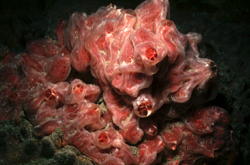Fit as a sponge
Sponges - a very old evolutionary lineage - lack true muscles but still have some proteins typically found in muscle cells. These new findings suggest that the origins of musculature lie much further back in time than suspected.
26.06.2012

An international team of researchers led by evolutionary biologist Professor Ulrich Technau of Vienna University has obtained genetic evidence for the presence of certain muscle proteins in sponges, a very old evolutionary lineage that lacks true muscle cells.“Hence, the origins of musculature lie much further back in time than we suspected,” says Professor Gert Wörheide of LMU‘s Geobio Center. Members of his research group contributed significantly to the new findings, in particular Humboldt Fellow Claire Larroux, who did much of the work on the sponges.
The jellyfish’s stripes
These muscle-related proteins are probably involved in cell motility and in regulating the circulation of water through the sponges’ characteristic pores. One is a type of myosin that is essential for the function, and the striated appearance, of skeletal muscle fibers in higher organisms.“This specific form of myosin was previously known only from true muscle cells, and was assumed to have originated during muscle evolution,” says Technau. “But it probably evolved long before the first multicellular animals arose.”
The new findings suggest that this myosin form, and other primordial muscle proteins, provided the basis for the evolution of muscles. The musculature of higher animals is the result of a process of duplication and functional diversification of the genes that encoded the early progenitor molecules. Thus, muscle development did not require the wholesale invention of new genes. The diverse consequences of this process emerged when the researchers looked at jellyfish, which evolved about 600 million years ago and have striated muscles.
“Structurally, jellyfish muscles resemble those of insects and vertebrates, suggesting that they share a common origin,” says Wörheide. “But our results show that, despite their common features, such as the presence of the primordial muscle myosin, there are important differences. The striated muscles of cnidarians and higher organisms most probably evolved independently.” The discovery once again confirms that very ancient elements found in simple cells repeatedly provided the foundation for the evolution of more complex structures. (Uni Vienna/suwe)
Publication
Independent evolution of striated muscles in cnidarians and bilaterians: Patrick R.H. Steinmetz, Johanna E.M. Kraus, Claire Larroux, Jörg U. Hammel, Annette Amon-Hassenzahl, Evelyn Houliston, Gert Wörheide, Michael Nickel, Bernard M. Degnan & Ulrich Technau. Nature (2012).
Contact





